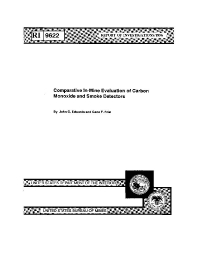 |
A series of liquid fuel fire experiments evaluated the comparative responses of five types of commercially available smoke detectors and a diffusion-mode carbon monoxide (CO) detector under normal and reduced airflow conditions based upon the alarm times of the detectors. These experiments were conducted in the Safety Research Coal Mine at the U.S. Bureau of Mines Pittsburgh Research Center. Two of the smoke detectors had manufacturer set alarms. For the other three smoke detectors, an alarm point was defined in terms of their background analog signal and the detector's electrical output noise under ambient conditions. A correlation was developed of the travel time of 5 ppm CO between pairs of CO detectors with the travel time calculated from entry and crosscut volumes and measured airflow. Based upon the relative performance of smoke detectors in this limited study, smoke detectors can be as effective as CO detectors for mine fire detection once identifiable alarm values are defined. Implementation of smoke detectors as part of an atmospheric mine monitoring system will improve mine safety.
| Author(s): | Edwards-JC, Friel-GF |
| Reference: | U.S. Department of the Interior, Bureau of Mines, Report of Investigations 9622. NTIS stock number: PB96-165188, 1996 :1-11 |
ri9622 (PDF, 1000 KB)
